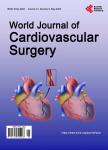Microbiological and Antibiotic Susceptibility Patterns in Cardiothoracic and Vascular Intensive Care Unit of a Tertiary Level Hospital in Nepal
Microbiological and Antibiotic Susceptibility Patterns in Cardiothoracic and Vascular Intensive Care Unit of a Tertiary Level Hospital in Nepal作者机构:Department of Cardiothoracic and Vascular Anesthesiology Manmohan Cardiothoracic Vascular and Transplant Center Tribhuvan University Kathmandu Nepal Department of Cardiothoracic and Vascular Surgery Manmohan Cardiothoracic Vascular and Transplant Center Tribhuvan University Kathmandu Nepal
出 版 物:《World Journal of Cardiovascular Surgery》 (心血管外科国际期刊(英文))
年 卷 期:2023年第13卷第3期
页 面:61-70页
主 题:Sepsis Antibiotics Intensive Care Unit
摘 要:Background: Sepsis has been one of the most important conditions for morbidity and mortality of Intensive care unit (ICU) patients. Antibiotics remain one of the major combating factors for it. Indiscriminate antimicrobial usage and poor prescription practices have contributed to the development of multidrug resistant (MDR) organisms. Therefore, the current study was designed to evaluate the spectrum, and susceptibility patterns of pathogens isolated from patients admitted to our Cardiothoracic and Vascular Intensive care unit. Materials and Methods: The study was conducted in Cardiothoracic and Vascular ICU of a tertiary care teaching hospital from February 2019 to March 2021. Samples (blood, urine, wound swab, tracheal aspirate, and central venous catheter tip) for culture were taken from all the patients in Sepsis admitted in Cardiothoracic and Vascular ICU above 18 years of age during the study period. The culture reports (microbiological profile and their susceptibility pattern) were collected and data collection of all enrolled patients was done. Results: Out of the total 128 samples studied 75 (58.5%) were culture positive. The predominant organisms isolated were Gram negative organisms (Klebsiella, Pseudomonas, Acinetobacter, followed by E. coli). The highest prevalence of microbial growth was found in tracheal aspirate (46.8%), followed by blood (21.8%). Antibiotic susceptibility results showed the highest sensitivity of those common pathogens towards higher antibiotics only (especially Polymyxin B and Colistin). Conclusion: The emergence of multidrug resistant organisms and lesser availability of a higher group of antibiotics is a major concern. So there is a need for regular hospital based antibiograms, strict infection control programs, and implementation of antimicrobial stewardship programmes for guiding clinicians in choosing appropriate therapy and preventing the surge of multidrug resistant organisms.



